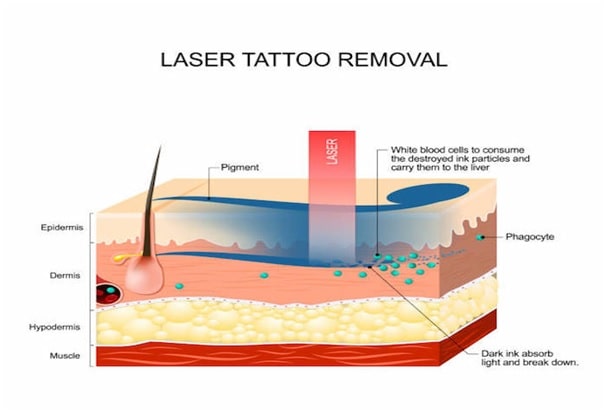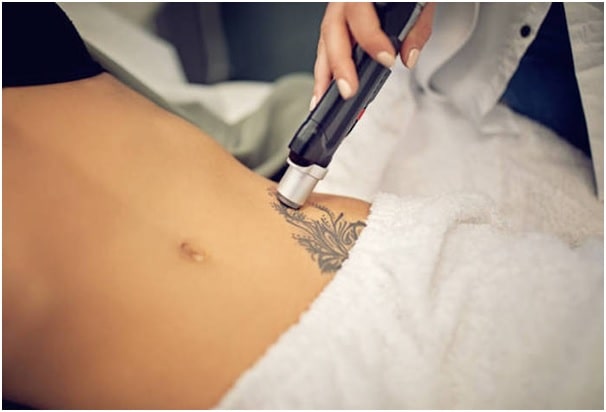
Removing a tattoo is a big decision. There are various methods, and the best one for you will depend on your tattoo type, its location on your body, and how long you’ve had it.
Fortunately, there are many ways to remove tattoos, and we will analyze the different types and how each one works. We will also discuss the stages of the process for each method and the contraindications.
What to expect from tattoo removal?
Tattoo removal can be a lengthy, uncomfortable process. The good news is that it is usually adequate, and the results are permanent. There are a few things to consider before removing a tattoo:
- The type of tattoo you have: Some of them are easier to remove than others. Black ink is generally easier to delete than color. Additionally, amateur tattoos are often easier to remove than professional ones.
- The size of your tattoo. Smaller tattoos will take less time to remove than larger ones.
- The skin type. People with darker skin may find it more difficult to remove a tattoo. People with sensitive skin may experience more pain and discomfort during the process.
- The location of your tattoo. Tattoos on areas like the hands, feet, or face may be more challenging to remove.
If you consider removing a tattoo, you must consult a dermatologist or another medical professional first. They can help you determine which method is proper for you and answer any questions about the process.
Types of tattoo removal
Tattoo removal is a multi-step process that can take several months to complete. It typically involves four stages: lightening, fading, peeling, and flaking. Different techniques are used during each step to remove the tattoo gradually.
There are two types of tattoo removal: surgical and nonsurgical. The surgical method is the most effective but expensive and invasive. It involves removing the tattoo with a laser or cutting it out. Nonsurgical tattoo removal is less effective but also less expensive and less invasive. It uses creams, gels, or lasers to break down the ink in the tattoo.
Every kind of tattoo removal has its advantages and disadvantages. Some standard methods include:
Laser removal
Laser tattoo removal is a successful and popular method for removing tattoos. The laser breaks up the ink into tiny fragments, which are then absorbed by the body. It can be done in a doctor’s office or clinic and usually takes between one and ten sessions to remove a tattoo. Treatment intervals are typically spaced six to eight weeks apart to allow the body time to absorb the ink fragments.
There are two types of laser: ablative and non-ablative. Ablative tattoo removal uses lasers to remove the top layers of skin, while non-ablative uses them to break up the ink particles without damaging the skin.
The side effects of laser tattoo removal are skin lightening, scarring, and burns. But non-ablative methods have a lower risk of them.

Surgical removal
The surgeon will remove the tattoo by cutting it and stitching the skin closed. The doctor covers the area with a bandage, and you must take antibiotics to help prevent infection. This method is usually only used for small tattoos.
The main disadvantage of surgical removal is that it can leave a scar. The size will depend on the scale of the tattoo and how well your skin heals. Another downside of this type is that it can be pretty expensive.
If you are considering surgical removal, be sure to consult with a board-certified plastic surgeon or dermatologist to discuss your options.
Dermabrasion
Dermabrasion is a technique that uses a rotating wire brush or diamond wheel to remove the top layers of skin. You can remove small areas of tattooing, as well as larger sizes. This method is often used to remove small, superficial tattoos. A dermatologist or plastic surgeon usually performs dermabrasion.
The procedure is done under local anesthesia and takes about 30 minutes. There is typically some discomfort during the operation, but it is manageable with over-the-counter pain medications.
Recovery from dermabrasion takes about two weeks when the treated area will be red and swollen. The swelling will gradually subside, and the tattoo’s color will lighten. Multiple treatments may be necessary for the complete removal of the tattoo.
Saline tattoo removal
If you’re looking for a more natural tattoo removal method, saline may be the right choice. Saline tattoo removal uses a solution of salt water to remove the ink from your skin. This method is less painful than laser tattoo removal and can be done at home.
This process can take several weeks or months, depending on the size and location of your tattoo. You will likely need to undergo multiple treatments, but there is no guarantee that you’ll delete the tattoo.
Chemical peels for tattoo removing
If you’re looking for a less invasive option to remove your tattoo, you may want to consider a chemical peel. Chemical peels use different acids to remove the outer layer of skin, which can help fade the tattoo.
Three types of chemical peels exist light, medium, and deep. The type of peel you need will depend on the depth of the tattoo and your skin type. The deeper the peel, the more effective it will remove a tattoo.
It typically takes two to five sessions to see results. After each treatment, your skin will be more sensitive to sunlight, so it’s essential to wear sunscreen and avoid sun exposure during your recovery period.

Contraindications for tattoo removal
You should know about all contraindications if you decide to remove a tattoo. Some of them are permanent, and others can change after some time. Here are the most crucial:
Strictly forbidden
Patients with the following conditions should not undergo tattoo removal:
- Autoimmune diseases such as vitiligo, psoriasis, lupus erythematosus, or alopecia areata;
- Immune system disorders;
- Haemophilia and other bleeding abnormalities;
- Cancer or precancerous lesions in the treatment area;
- Diabetes mellitus;
- HIV and hepatitis;
- A history of keloid scarring;
- Allergic reaction to the previous tattoo removal session;
- Using some medications, including certain antibiotics and antihistamines.
Ask your doctor
Several conditions need a doctor’s letter confirming the treatment is suitable before treatments can begin:
- Cardiovascular disease;
- If you have had radiation therapy in the past 12 months;
- If you have had surgery in the last six months;
- Epilepsy;
- Thyroid diseases;
- Immunosuppression treatment.
Wait for a specific period
Also, some conditions need some time to pass before removing a tattoo. They include:
- Pregnancy and breastfeeding;
- Active skin infection or viral infection such as herpes simplex, chickenpox, or shingles;
- Dermatitis or eczema in the treatment area;
- Sunburned or tanned skin;
- Active acne breakouts;
- If you have had any recent laser treatments or surgeries in the treatment area.
Besides, waiting until your tattoo is completely healed before starting treatments would be best. The tattoo must be at least 90 days old.
Summary
There are many reasons why someone might want to remove a tattoo. If you want to remove a tattoo, it is essential to understand the process and what is involved. Removing a tattoo can take anywhere from a few weeks to several months, depending on the size and location of the tattoo. It’s essential to be patient and follow your doctor’s instructions. With the proper preparation, tattoo removal can be a successful and satisfying experience, and you can move on with your life.
Author bio:
Olivia Sanders is a Content Marketer for a couple of businesses in the United States and is a contributor to Ink-Match. She enjoys writing articles and creating content that can be found on the web, social media, and print media. She has a passion for writing about the world around her and sharing her thoughts with others.
